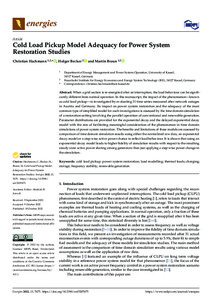Cold Load Pickup Model Adequacy for Power System Restoration Studies
| dc.date.accessioned | 2022-10-27T06:42:14Z | |
| dc.date.available | 2022-10-27T06:42:14Z | |
| dc.date.issued | 2022-10-18 | |
| dc.identifier | doi:10.17170/kobra-202210267040 | |
| dc.identifier.uri | http://hdl.handle.net/123456789/14219 | |
| dc.description.sponsorship | Gefördert durch den Publikationsfonds der Universität Kassel | ger |
| dc.language.iso | eng | |
| dc.rights | Namensnennung 4.0 International | * |
| dc.rights.uri | http://creativecommons.org/licenses/by/4.0/ | * |
| dc.subject | cold load pickup | eng |
| dc.subject | power system restoration | eng |
| dc.subject | load modelling | eng |
| dc.subject | thermal loads | eng |
| dc.subject | charging | eng |
| dc.subject | storage | eng |
| dc.subject | frequency stability | eng |
| dc.subject | renewable generation | eng |
| dc.subject.ddc | 333 | |
| dc.title | Cold Load Pickup Model Adequacy for Power System Restoration Studies | eng |
| dc.type | Aufsatz | |
| dcterms.abstract | When a grid section is re-energized after an interruption, the load behaviour can be significantly different from normal operation. In this manuscript, the impact of the phenomenon—known as cold load pickup—is investigated by evaluating 31 time series measured after network outages in Austria and Germany. Its impact on power system restoration and the adequacy of the most common type of simplified model for such investigations is assessed by the time domain simulation of a restoration setting involving the parallel operation of conventional and renewable generation. Parameter distributions are provided for the exponential decay and the delayed exponential decay model with the aim of facilitating meaningful consideration of the phenomenon in time domain simulations of power system restoration. The benefits and limitations of these models are assessed by comparison of time domain simulation results using either the normalized raw data, an exponential decay model or a step-wise active power chance to reflect load behaviour. It is shown that using an exponential decay model leads to higher fidelity of simulation results with respect to the resulting steady-state active power sharing among generators than just applying a step-wise power change in the simulation. | eng |
| dcterms.accessRights | open access | |
| dcterms.creator | Hachmann, Christian | |
| dcterms.creator | Becker, Holger | |
| dcterms.creator | Braun, Martin | |
| dc.relation.doi | doi:10.3390/en15207675 | |
| dc.subject.swd | Österreich | ger |
| dc.subject.swd | Deutschland | ger |
| dc.subject.swd | Elektrizitätsversorgungsnetz | ger |
| dc.subject.swd | Erneuerbare Energien | ger |
| dc.subject.swd | Frequenzstabilität | ger |
| dc.subject.swd | Energiespeicherung | ger |
| dc.subject.swd | Stromausfall | ger |
| dc.type.version | publishedVersion | |
| dcterms.source.identifier | eissn:1996-1073 | |
| dcterms.source.issue | Issue 20 | |
| dcterms.source.journal | Energies | eng |
| dcterms.source.volume | Volume 15 | |
| kup.iskup | false | |
| dcterms.source.articlenumber | 7675 |
Dateien zu dieser Ressource
Das Dokument erscheint in:
-
Artikel [1106]


